|
|
 |
Baked S'mores Cheesecake—Prototype 1:
2-to-1 Blend of Yogurt Cheese and Cottage Cheese:
Prepare ahead of time (allow at least 24 hours) 32 ounces of yogurt cheese,
derived from two 32-ounce containers (that's 64 ounces altogether) of nonfat
yogurt. If the resulting yogurt cheese falls below 32 ounces, add back enough of
the whey (that was strained out from the yogurt) to make up the difference. To
this yogurt cheese combine one 16-ounce container of whipped, lowfat cottage
cheese.
Grease a 9 1/2" (or 9") springform pan, but do not wrap foil around it
until just before the batter is added (spreading the crust in an already wrapped
pan can result in greater disturbance to the foil, thus increasing leakage
risks).
Graham Crust:
2 oz. melted, white chocolate
8 oz. (1 cup) 2-to-1 blend of yogurt cheese and cottage cheese (see above)
1/4 cup granulated sugar
1/4 cup brown sugar
2 teaspoons cinnamon
1/2 teaspoon vanilla
Completely blend the above ingredients first, then continue with the ingredient
below, mixing it in quickly.
3 oz. graham crackers, ground up (Mi-Del 100% Whole Wheat Honey Grahams
recommended)
Note: Because this crust already includes cinnamon in the ingredients shown
above, non-cinnamon graham crackers are strongly recommended. But if cinnamon
grahams are going to be used, omit the 2 teaspoons of cinnamon (also, the sugar
listed above, granulated and/or brown, should probably be somewhat reduced in such
a case).
Place resulting crust mixture into bottom of the springform pan and pre-bake
without tub at 300 degrees for 8 minutes, then cool enough to comfortably touch
at least the pan's upper sidewall.
Chocolate Batter:
4 tablespoons melted/softened butter
3/8 cup cocoa powder
1 3/4 cups granulated sugar
1/4 cup all-purpose flour
3 tablespoons arrowroot
40 ounces (5 cups) 2-to-1 blend of yogurt cheese and cottage cheese (see above)
2 teaspoons vanilla
4 eggs
2 cups miniature marshmallows
Expect about 7 to 7 1/2 cups of the resulting batter, but do not add this to the pan all
at once. Rather, this needs to be done in six installments.
Wrap the pan in foil just before adding the first batter installment.
For each of the first four installments, gently scoop about 1 1/4 cups of batter
into the pan. Add about 1/2 cup of the marshmallows, ensuring that they are
fully coated and—as much as possible—immersed. After adding an
installment, bake the pan with its contents at 325 degrees for 15 minutes, in a
tub filled with at least 1/4 to 1/2 inch of boiling water. To reduce spillage
risks, do not fill the tub all the way at this point, because the whole
tub-and-pan assembly is going to need to be removed from the oven (in order to
comfortably add contents to the pan) between installments.
After all this is done, there should be about 1 to 1 1/2 cups of batter left, with
60 minutes of baking time reached at this point (15 minutes for each of the first
four installments). Now comes the fifth installment—carefully add about half
of this remaining batter (do not add any more marshmallows at this point) on top of the
pan's other contents. Try to fully coat the entire surface, especially wherever
marshmallows may be showing, some of which may keep on floating to the top—but
do not be too concerned about this. Next, return the entire pan-and-tub assembly to the
oven, but with the temperature lowered to 300 degrees, for 15 minutes. Then take this
assembly out and add the last of the batter (the sixth installment),
coating the remaining exposed marshmallows
as much possible. At this point, fill up the tub generously with boiling water. Resume
baking at 300 degrees, for another 60 minutes (based upon usage of a 9 1/2"
pan).
Afterward, shut the oven off, and leave its door slightly ajar, with the
cheesecake still inside—and in the tub—for an hour. Next, remove the
cheesecake from the oven and tub, and add a border of milk chocolate chips
around the edge of this cheesecake (see photo below). Continue to cool it down
at room temperature for another two hours. After doing so, remove the cheesecake
from pan and refrigerate.
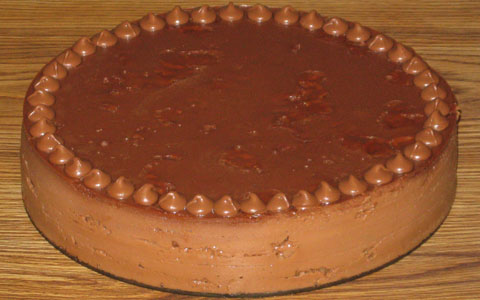
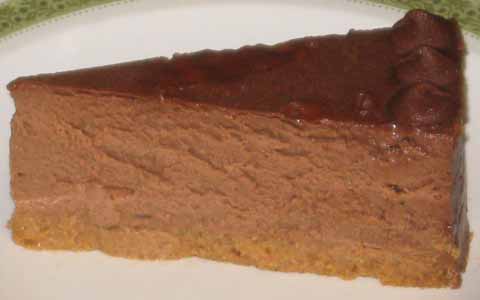
Baked S'mores Cheesecake—Prototype 2:
2-to-1 Blend of Yogurt Cheese and Cottage Cheese:
Prepare ahead of time (allow at least 24 hours) 32 ounces of yogurt cheese,
derived from two 32-ounce containers (that's 64 ounces altogether) of nonfat
yogurt. If the resulting yogurt cheese falls below 32 ounces, add back enough of
the whey (that was strained out from the yogurt) to make up the difference. To
this yogurt cheese combine one 16-ounce container of whipped, lowfat cottage
cheese.
Grease a 9 1/2" (or 9") springform pan, but do not wrap foil around it
until just before the batter is added (spreading the crust in an already wrapped
pan can result in greater disturbance to the foil, thus increasing leakage
risks).
Graham Crust:
2 oz. melted, white chocolate
8 oz. (1 cup) 2-to-1 blend of yogurt cheese and cottage cheese (see above)
1/4 cup granulated sugar
1 tablespoon brown sugar
1/2 teaspoon vanilla
Completely blend the above ingredients first, then continue with the ingredient
below, mixing it in quickly.
3 oz. cinnamon graham crackers, ground up (such as Annie's Cinnamon Grahams)
Place resulting crust mixture into bottom of the springform pan and pre-bake
without tub at 300 degrees for 8 minutes, then cool enough to comfortably touch
at least the pan's upper sidewall.
Chocolate Batter:
4 tablespoons melted/softened butter
3/8 cup cocoa powder
1 3/4 cups granulated sugar
1/4 cup all-purpose flour
3 tablespoons arrowroot
40 ounces (5 cups) 2-to-1 blend of yogurt cheese and cottage cheese (see above)
2 teaspoons vanilla
4 eggs
18 - 20 marshmallows (regular size)
Expect about 7 to 7 1/2 cups of the resulting batter, but do not add this to the pan all
at once. Rather, this needs to be done in four installments.
Wrap the pan in foil just before adding the first batter installment.
For each of the first two installments, gently scoop about 2 1/2 cups of batter
into the pan. Add about 9 or 10 marshmallows, ensuring that they are at least
fully coated (they do not need to be fully immersed). After adding an
installment, bake the pan with its contents at 325 degrees for 25 minutes, in a
tub filled with at least 1/4 to 1/2 inch of boiling water. To reduce spillage
risks, do not fill the tub all the way at this point, because the whole
tub-and-pan assembly is going to need to be removed from the oven (in order to
comfortably add contents to the pan) between installments.
After all this is done, there should be about 1 to 1 1/2 cups of batter left, with
50 minutes of baking time reached at this point (25 minutes for each of the first
two installments). Now comes the third installment—carefully add about half
of this remaining batter (do not add any more marshmallows at this point) on top of the
pan's other contents. Try to fully coat the entire surface, especially wherever
marshmallows may be showing, some of which may keep on floating to the top—but
do not be too concerned about this. Next, return the entire pan-and-tub assembly to the
oven, but with the temperature lowered to 300 degrees, for 15 minutes. Then take this
assembly out and add the last of the batter (the fourth installment),
coating the remaining exposed marshmallows
as much possible. At this point, fill up the tub generously with boiling water. Resume
baking at 300 degrees, for another 60 minutes (based upon usage of a 9 1/2"
pan).
Afterward, shut the oven off, and leave its door slightly ajar, with the
cheesecake still inside—and in the tub—for an hour. Next, remove the
cheesecake from the oven and tub, and add a border of milk chocolate chips
around the edge of this cheesecake (see photo below). Continue to cool it down
at room temperature for another two hours. After doing so, remove the cheesecake
from pan and refrigerate.
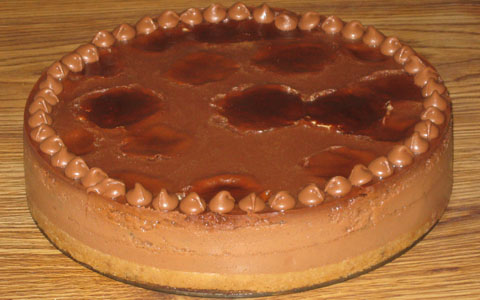
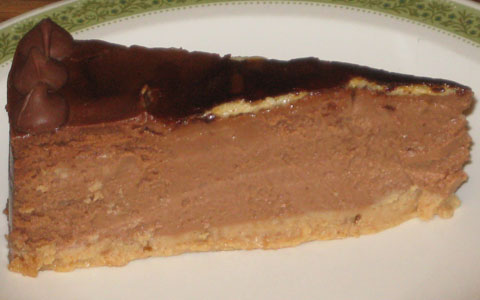
Baked S'mores Cheesecake—Prototype 3:
2-to-1 Blend of Yogurt Cheese and Cottage Cheese:
Prepare ahead of time (allow at least 24 hours) 32 ounces of yogurt cheese,
derived from two 32-ounce containers (that's 64 ounces altogether) of nonfat
yogurt. If the resulting yogurt cheese falls below 32 ounces, add back enough of
the whey (that was strained out from the yogurt) to make up the difference. To
this yogurt cheese combine one 16-ounce container of whipped, lowfat cottage
cheese.
Grease a 9 1/2" (or 9") springform pan, but do not wrap foil around it
until just before the batter is added (spreading the crust in an already wrapped
pan can result in greater disturbance to the foil, thus increasing leakage
risks).
Graham Crust:
2 oz. melted, white chocolate
8 oz. (1 cup) 2-to-1 blend of yogurt cheese and cottage cheese (see above)
1/4 cup granulated sugar
1 tablespoon brown sugar
1/2 teaspoon vanilla
Completely blend the above ingredients first, then continue with the next
ingredient, shown immediately below.
2 cups miniature marshmallows
Fully combine this with the other above ingredients, then continue afterwards
with the last crust ingredient below, mixing it in quickly.
4 oz. cinnamon graham crackers, ground up (such as Annie's Cinnamon Grahams)
Place resulting crust mixture into bottom of the springform pan and pre-bake
without tub at 300 degrees for 10 minutes, then cool enough to comfortably touch
at least the pan's upper sidewall.
Chocolate Batter:
4 tablespoons melted/softened butter
3/8 cup cocoa powder
1 3/4 cups granulated sugar
1/4 cup all-purpose flour
3 tablespoons arrowroot
40 ounces (5 cups) 2-to-1 blend of yogurt cheese and cottage cheese (see above)
2 teaspoons vanilla
4 eggs
Wrap the pan in foil at this point. Carefully pour the batter over the crust and
bake this cheesecake in a hot water tub at 300 degrees for 110 minutes (if using
a 9 1/2" pan). Then shut off oven and cool the cheesecake down while still
in it (and in tub), with door slightly ajar, for an hour. Afterwards, remove
this cheesecake from oven and tub, and add a border of milk chocolate chips
on top, around the cheesecake's edge (see photo below). Continue to cool it down
at room temperature for another 110 minutes. After doing so, remove the cheesecake
from pan and refrigerate.
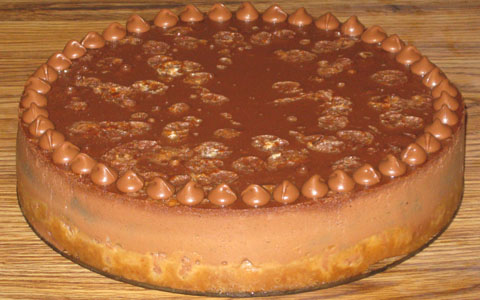
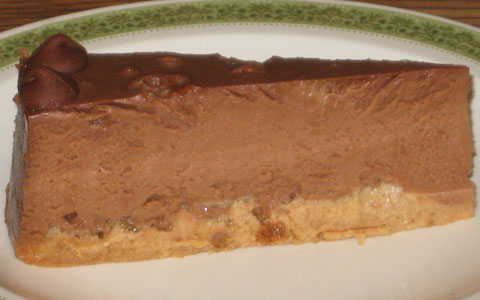
Baked S'mores Cheesecake—Prototype 4:
3-Cheese Blend (1CT-1NC-4YG):
Prepare ahead of time 32 ounces of yogurt cheese, derived from two 32-ounce
containers (that's 64 ounces altogether) of nonfat yogurt. If the resulting
yogurt cheese falls below 32 ounces, add back enough of the whey (that was
strained out from the yogurt) to make up the difference. To this yogurt cheese
combine 8 ounces of whipped, lowfat cottage cheese and 8 ounces of softened
Neufchatel cheese ("light cream cheese").
Grease a 9 1/2" (or 9") springform pan, but do not wrap foil around it
until just before the batter is added (spreading the crust in an already wrapped
pan can result in greater disturbance to the foil, thus increasing leakage
risks).
Graham Crust:
2 oz. melted, white chocolate
8 oz. (1 cup) 3-cheese blend (see above)
1/4 cup granulated sugar
1 tablespoon brown sugar
1/2 teaspoon vanilla
Completely blend the above ingredients first, then continue with the next
one below.
4 oz. cinnamon graham crackers, ground up
Get this fully mixed in (moistened) with the other ingredients above.
Afterwards, promptly add in and fully coat the last crust ingredient below.
2 cups miniature marshmallows
Place resulting crust mixture into bottom of the springform pan and pre-bake
without tub at 300 degrees for 15 minutes, then cool enough to comfortably touch
at least the pan's upper sidewall.
Chocolate Batter:
1 3/4 cups granulated sugar
3/8 cup cocoa powder
40 oz. (5 cups) 3-cheese blend (see above)
1/4 cup + 1 tablespoon (5 tablespoons altogether) arrowroot
2 teaspoons vanilla
5 eggs
Expect about 7 to 7 1/2 cups of the resulting batter, but do not add this to the
pan all at once. Rather, this needs to be done in four installments.
Wrap the pan in foil just before adding the first batter installment.
For each of the first three installments, gently scoop about 1 cup of batter
into the pan while trying to coat—as much as possible—the previous
crust or batter layer below, especially the marshmallows that are still exposed
on top (it's okay if some of them end up not being completely coated at first—the
later a given installment, the more likely that these marshmallows are going to
get fully immersed). After adding an installment, bake the pan with its contents
for 25 minutes—at 325 degrees for the first two installments and at 300
degrees for the third—in a tub filled with at least 1/4 to 1/2 inch of
boiling water. To reduce spillage risks, do not fill the tub all the way at this
point, because the whole tub-and-pan assembly is going to need to be removed
from the oven (in order to comfortably add contents to the pan) between
installments.
After all this is done, there should be close to half of the batter left, with
75 minutes of baking time reached at this point (25 minutes for each of the
first three installments). Now comes the fourth (and last) installment—carefully
add this remaining batter on top of the pan's other contents. Try to fully coat
the entire surface, especially wherever marshmallows may still be showing. Next,
return the entire pan-and-tub assembly to the oven, fill up the tub generously
with boiling water, and resume baking at 300 degrees for another 95 minutes
(based upon usage of a 9 1/2" pan).
Afterward, shut the oven off, and leave its door slightly ajar, with the
cheesecake still inside—and in the tub—for an hour. Next, remove the
cheesecake from the oven and tub, and—if desired—add a border of
milk chocolate chips (or use another variety—but milk chocolate is
recommended for s'mores!) around the edge of this cheesecake. Continue to cool
it down at room temperature for another two hours. After doing so, remove the
cheesecake from pan and refrigerate.
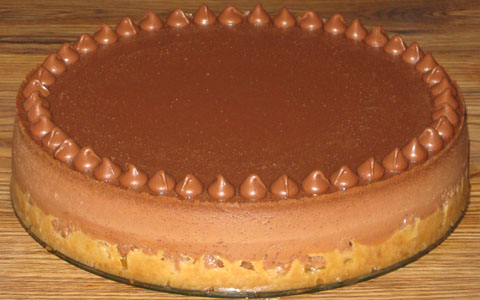
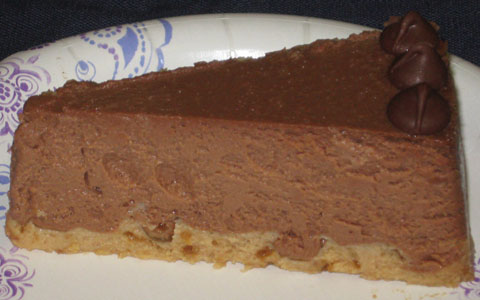
Baked S'mores Cheesecake—Prototype 5:
3-Cheese Blend (3CT-1NC-2YG):
Prepare ahead of time 16 ounces of yogurt cheese, derived from one 32-ounce
container of nonfat yogurt. If the resulting yogurt cheese falls below 16
ounces, add back enough of the whey (that was strained out from the yogurt) to
make up the difference. To this yogurt cheese combine 24 ounces of whipped,
lowfat cottage cheese and 8 ounces of softened Neufchatel cheese ("light
cream cheese").
Grease a 9 1/2" (or 9") springform pan, but do not wrap foil around
it until just before the batter is added above the crust layers (spreading the
crust in an already wrapped pan can result in greater disturbance to the foil,
thus increasing leakage risks).
Graham Crust—First Layer:
2 oz. melted, white chocolate
8 oz. (1 cup) 3-cheese blend (see above)
1/4 cup granulated sugar
1 tablespoon brown sugar
1/2 teaspoon vanilla
Completely blend the above ingredients first, then continue with the next
one below.
4 oz. cinnamon graham crackers, ground up
Get this fully mixed in (moistened) with the other ingredients above.
Afterwards, promptly add in and fully coat the last crust ingredient below.
2 cups miniature marshmallows
Place resulting crust mixture into bottom of the springform pan and pre-bake
without tub at 300 degrees for 15 minutes, then remove from oven and cool at
least slightly.
Chocolate Batter:
1 3/4 cups granulated sugar
3/8 cup cocoa powder
40 oz. (5 cups) 3-cheese blend (see above)
1 1/2 teaspoons xanthan gum
2 teaspoons vanilla
6 eggs
Reserve some of this batter for the second crust layer, as indicated below.
Graham Crust—Second Layer:
1 1/2 cups chocolate batter (see above)
1 tablespoon brown sugar
Completely blend these two ingredients first, then continue with the next
one below.
3 oz. cinnamon graham crackers, ground up
Combine these three crust ingredients and promptly place this mixture into the pan on
top of the first crust layer. Try to conceal, as much as possible, every trace of
marshmallow that is showing through the top of the first layer, then immediately put
the pan back into the oven. Bake this, still without tub, at 300 degrees for another 15
minutes, then cool it enough to comfortably touch at least the pan's upper sidewall.
Next, wrap the pan in foil. Carefully pour the remaining chocolate batter over
the second crust layer and bake this cheesecake in a hot water tub at 300 degrees for
70 minutes (if using a 9 1/2" pan). Afterward, shut the oven off, and leave its
door slightly ajar, with the cheesecake still inside—and in the tub—for an
hour. Next, remove the cheesecake from the oven and tub. Now, for the final chocolate
touch, add a border of chocolate chips (milk chocolate strongly recommended in
keeping with the s'mores tradition!) around the edge of this cheesecake (see photo
below). Continue to cool it down at room temperature for another two hours. After
doing so, remove the cheesecake from pan and refrigerate.
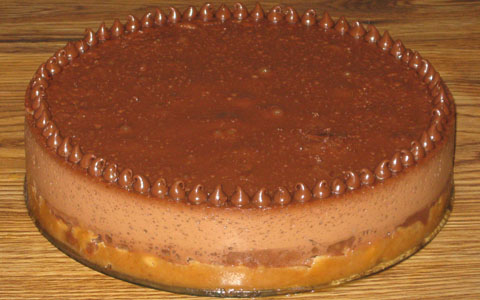
Baked S'mores Cheesecake—Prototype 6:
3-Cheese Blend (1CT-1NC-1YG):
Prepare ahead of time 16 ounces of yogurt cheese, derived from one 32-ounce
container of nonfat yogurt. If the resulting yogurt cheese falls below 16
ounces, add back enough of the whey (that was strained out from the yogurt) to
make up the difference. To this yogurt cheese combine 16 ounces of whipped,
lowfat cottage cheese and 16 ounces (two 8-ounce packages) of softened
Neufchatel cheese ("light cream cheese").
Grease a 9 1/2" (or 9") springform pan, but do not wrap foil around
it until just before the batter is added above the crust layers (spreading the
crust in an already wrapped pan can result in greater disturbance to the foil,
thus increasing leakage risks).
Graham Crust—First Layer:
2 oz. melted, white chocolate
8 oz. (1 cup) 3-cheese blend (see above)
1/4 cup granulated sugar
1 tablespoon brown sugar
1 teaspoon cinnamon
1/2 teaspoon vanilla
Completely blend the above ingredients first, then continue with the next
one below.
4 oz. graham crackers, ground up (if these are cinnamon-flavored, omit the
cinnamon shown above)
Get this fully mixed in (moistened) with the other ingredients above.
Afterwards, promptly add in and fully coat the last crust ingredient below.
2 cups miniature marshmallows
Place resulting crust mixture into bottom of the springform pan and pre-bake
without tub at 300 degrees for 15 minutes, then remove from oven and cool at
least slightly.
Chocolate Batter:
1 3/4 cups granulated sugar
3/8 cup cocoa powder
40 oz. (5 cups) 3-cheese blend (see above)
1 teaspoon xanthan gum
2 teaspoons vanilla
6 eggs
Reserve some of this batter for the second crust layer, as indicated below.
Graham Crust—Second Layer:
1 1/2 cups chocolate batter (see above)
1 tablespoon brown sugar
1 teaspoon cinnamon
Completely blend these three (or two if the cinnamon is excluded) ingredients
first, then continue with the next one below.
3 oz. graham crackers, ground up (if these are cinnamon-flavored, omit the
cinnamon shown above)
Combine these four (or three) crust ingredients and promptly place this mixture into
the pan on top of the first crust layer. Try to conceal, as much as possible, every
trace of marshmallow that is showing through the top of the first layer, then
immediately put the pan back into the oven. Bake this, still without tub, at 300
degrees for another 15 minutes, then cool it enough to comfortably touch at least the
pan's upper sidewall.
Next, wrap the pan in foil. Carefully pour the remaining chocolate batter over
the second crust layer and bake this cheesecake in a hot water tub at 300 degrees for
65 minutes (if using a 9 1/2" pan). Afterward, shut the oven off, and leave its
door slightly ajar, with the cheesecake still inside—and in the tub—for an
hour. Next, remove the cheesecake from the oven and tub. Now, for the final chocolate
touch, add a border of chocolate chips (milk chocolate strongly recommended in
keeping with the s'mores tradition!) around the edge of this cheesecake (see photo
below). Continue to cool it down at room temperature for another two hours. After
doing so, remove the cheesecake from pan and refrigerate.
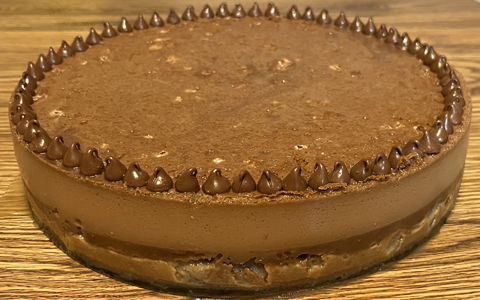
|
|

|